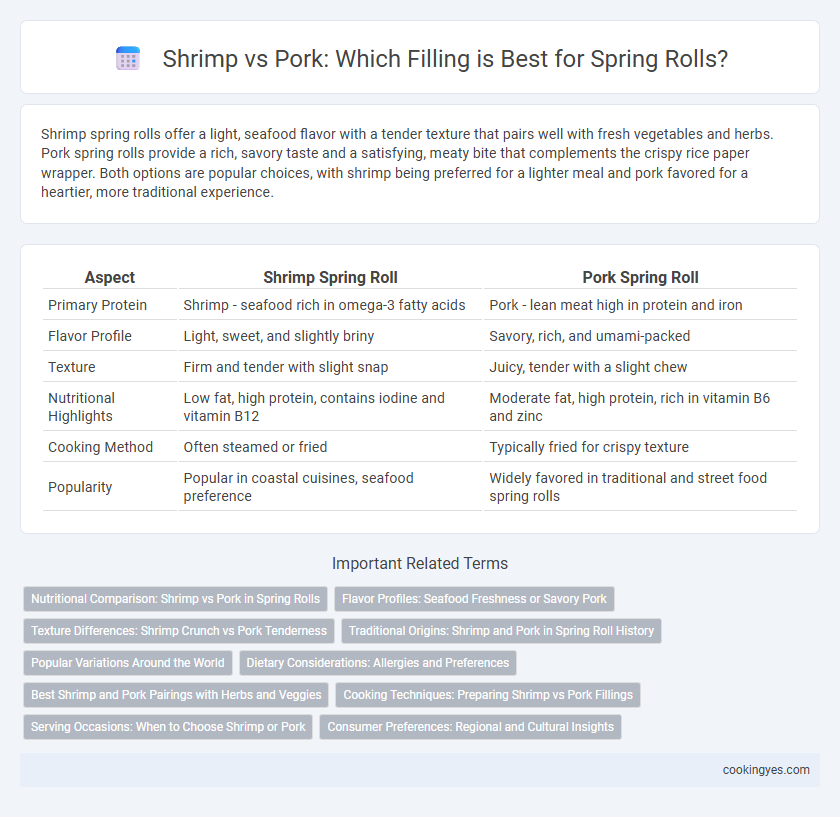Shrimp spring rolls offer a light, seafood flavor with a tender texture that pairs well with fresh vegetables and herbs. Pork spring rolls provide a rich, savory taste and a satisfying, meaty bite that complements the crispy rice paper wrapper. Both options are popular choices, with shrimp being preferred for a lighter meal and pork favored for a heartier, more traditional experience.
Table of Comparison
| Aspect | Shrimp Spring Roll | Pork Spring Roll |
|---|---|---|
| Primary Protein | Shrimp - seafood rich in omega-3 fatty acids | Pork - lean meat high in protein and iron |
| Flavor Profile | Light, sweet, and slightly briny | Savory, rich, and umami-packed |
| Texture | Firm and tender with slight snap | Juicy, tender with a slight chew |
| Nutritional Highlights | Low fat, high protein, contains iodine and vitamin B12 | Moderate fat, high protein, rich in vitamin B6 and zinc |
| Cooking Method | Often steamed or fried | Typically fried for crispy texture |
| Popularity | Popular in coastal cuisines, seafood preference | Widely favored in traditional and street food spring rolls |
Nutritional Comparison: Shrimp vs Pork in Spring Rolls
Shrimp in spring rolls offers a lean source of protein with lower calories and fat compared to pork, making it ideal for calorie-conscious diets. Pork provides higher amounts of essential vitamins like B12 and minerals such as zinc and iron, supporting energy metabolism and immune health. Both proteins supply valuable nutrients, but shrimp stands out for heart-healthy omega-3 fatty acids while pork delivers more saturated fat and cholesterol.
Flavor Profiles: Seafood Freshness or Savory Pork
Shrimp in spring rolls delivers a bright, oceanic sweetness that enhances the dish with a fresh, crisp texture, creating a light and refreshing bite. Pork provides a rich, savory depth with its umami-packed flavor and slightly fatty, tender texture, offering a hearty and satisfying contrast. Choosing between shrimp and pork depends on preference for a clean, seafood freshness or a robust, meaty savoriness in spring roll flavor profiles.
Texture Differences: Shrimp Crunch vs Pork Tenderness
Shrimp spring rolls deliver a satisfying crunch from the firm, slightly chewy texture of cooked shrimp, enhancing the overall bite experience. Pork spring rolls offer a contrasting tender, juicy texture that melts in the mouth, providing a richer and heartier feel. Choosing between shrimp and pork depends on whether you prefer a crisp, light crunch or a soft, succulent tenderness in your spring rolls.
Traditional Origins: Shrimp and Pork in Spring Roll History
Shrimp and pork have both been essential ingredients in traditional spring roll recipes across various Asian cultures, with pork commonly featured in Chinese spring rolls and shrimp more prevalent in Vietnamese versions such as Goi cuon. The choice between shrimp and pork reflects regional taste preferences and availability, shaping the distinct textures and flavors associated with these spring roll variations. Historically, pork offered a rich, savory profile, while shrimp introduced a delicate sweetness, highlighting the evolution of spring rolls from street food to a celebrated culinary staple.
Popular Variations Around the World
Shrimp spring rolls, known for their light, fresh flavor and commonly used in Vietnamese and Thai cuisines, provide a seafood alternative rich in protein and low in fat. Pork spring rolls, favored in Chinese and Filipino variations, offer a hearty, savory taste with a tender texture that pairs well with a variety of dipping sauces. Both variations highlight regional preferences and ingredient availability, contributing to the global popularity and diverse adaptations of spring rolls.
Dietary Considerations: Allergies and Preferences
Shrimp spring rolls pose a significant allergy risk due to shellfish sensitivity, making pork spring rolls a safer option for those with seafood allergies. Pork spring rolls offer a savory taste preferred by many who avoid shellfish for dietary or religious reasons. Both options provide protein but require careful consideration of individual allergies and preferences to ensure safe and enjoyable consumption.
Best Shrimp and Pork Pairings with Herbs and Veggies
Shrimp pairs exceptionally well with fresh mint, cilantro, and crisp cucumber in spring rolls, creating a light and aromatic flavor profile. Pork complements robust herbs like Thai basil and garlic chives, enhancing the savory richness when combined with crunchy bean sprouts and shredded carrots. Balancing these proteins with vibrant veggies and herbs elevates the texture and taste, making shrimp and pork spring rolls uniquely satisfying.
Cooking Techniques: Preparing Shrimp vs Pork Fillings
When preparing shrimp fillings for spring rolls, blanching or quick sauteing preserves their delicate texture and natural sweetness. Pork fillings require thorough cooking through stir-frying or simmering to ensure tenderness and flavor development while eliminating any raw taste. Precise temperature control is critical for both proteins to maintain optimal moisture and prevent toughness in the final spring roll.
Serving Occasions: When to Choose Shrimp or Pork
Shrimp spring rolls are ideal for light appetizers at summer parties or seafood-themed gatherings, offering a fresh and delicate flavor that pairs well with dipping sauces like sweet chili. Pork spring rolls suit heartier meals and family dinners, providing a savory, rich taste that complements robust side dishes and festive celebrations. Choosing between shrimp and pork depends on the event's ambiance, guest preferences, and desired flavor intensity for the spring roll experience.
Consumer Preferences: Regional and Cultural Insights
Consumer preferences for shrimp versus pork in spring rolls vary significantly across regions and cultures, with shrimp favored in coastal Asian areas such as Vietnam and Thailand for its light, seafood flavor aligning with local palates. In contrast, pork is preferred in northern Chinese and some Western adaptations, appreciated for its rich, savory taste and heartier texture that complements traditional seasoning blends. These differences highlight the impact of regional ingredient availability and cultural taste profiles on spring roll filling choices, influencing market demand and culinary innovation.
Shrimp vs pork for spring rolls Infographic

 cookingyes.com
cookingyes.com